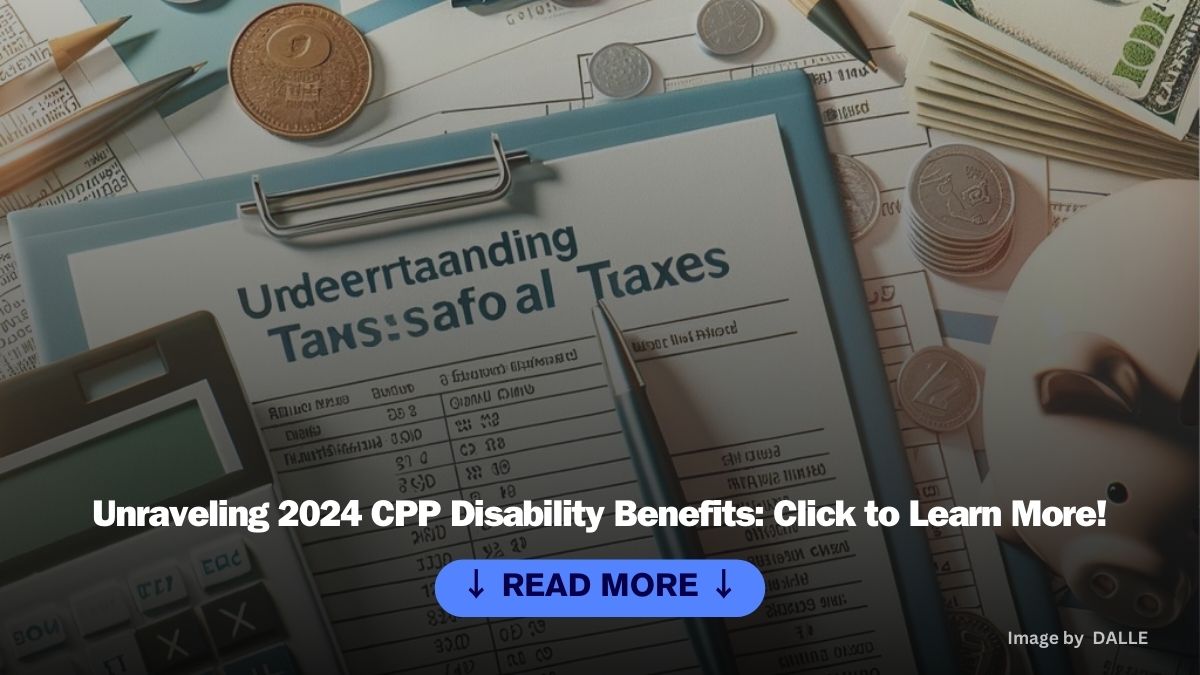Key Takeaways
- CPP disability benefits are monthly payments for eligible CPP contributors who have a severe and prolonged disability that prevents them from working.
- The maximum monthly CPP disability benefit for 2024 is $1,645.54, but the average amount is $1,127.30.
- To qualify for CPP disability benefits, you must be under 65, have made enough contributions to CPP, and have a disability that meets the CPP definition.
- CPP disability benefits are taxable and may be reduced by other sources of disability income, such as private insurance or provincial programs.
- CPP disability benefits are indexed to inflation and may increase every year based on the Consumer Price Index.
- CPP disability benefits automatically convert to CPP retirement pension when you turn 65.

What are CPP Disability Benefits?
The Canada Pension Plan (CPP) disability benefits are monthly payments that provide financial assistance to eligible CPP contributors who have a severe and prolonged disability that prevents them from working. The CPP disability benefits are designed to supplement your income and help you cover your living expenses in retirement.
The CPP disability benefits are part of the CPP, which is a contributory pension plan funded by employees and employers. All working Canadians over the age of 18 must contribute a percentage of their earnings to the CPP, up to a maximum amount. These contributions are invested and grow over time, and provide a source of retirement income for CPP contributors.
The CPP disability benefits are not based on your income or assets, but on your contributions and earnings history. The more you have contributed to the CPP and the higher your earnings, the higher your CPP disability benefit will be.
How Much are CPP Disability Benefits?
The amount of CPP disability benefits you can receive depends on several factors, such as your age, your contributions, your earnings, and the cost of living. The CPP disability benefits consist of a flat-rate portion and an earnings-related portion.
The flat-rate portion is the same for everyone and is $583.32 per month in 2024. The earnings-related portion is based on your average earnings and contributions in the five years before you became disabled, or the highest five years in your contributory period, whichever is higher. The earnings-related portion is 75% of your CPP retirement pension amount.
The maximum monthly CPP disability benefit for 2024 is $1,645.54, but the average amount is $1,127.30. The minimum amount is $583.32, which is the flat-rate portion only.
The CPP disability benefits are reviewed every January to reflect changes in the cost of living. The benefits are indexed to inflation and may increase every year based on the Consumer Price Index (CPI). The CPI measures the average change in prices of goods and services that Canadians buy. Indexing ensures that CPP disability benefits keep up with the rising cost of living.
How to Qualify for CPP Disability Benefits?
To qualify for CPP disability benefits, you must meet three main criteria:
- You must be under 65 years old. If you are 65 or older, you are not eligible for CPP disability benefits, but you can receive the CPP retirement pension instead.
- You must have made enough contributions to the CPP. You must have contributed to the CPP for at least four of the last six years, or three of the last six years if you have contributed for at least 25 years. You must also have contributed a minimum amount in each year, which is 10% of the Year’s Maximum Pensionable Earnings (YMPE). The YMPE is the maximum amount of earnings that are subject to CPP contributions, and it is $68,500 in 2024.
- You must have a disability that meets the CPP definition. Your disability must be both severe and prolonged, as defined by the CPP legislation. Severe means that you have a mental or physical disability that regularly prevents you from doing any type of substantially gainful work. Substantially gainful work means work that pays more than $1,000 per month in 2024. Prolonged means that your disability is long-term and of indefinite duration, or is likely to result in death.
How to Apply for CPP Disability Benefits?
To apply for CPP disability benefits, you must complete and submit two forms:
- An application form, which includes a questionnaire and a consent form. The application form asks for your personal information, your work history, your medical condition, and your income sources. The questionnaire helps to assess your disability and how it affects your daily activities. The consent form allows the CPP to access your medical and tax records.
- A medical report, which must be completed and signed by your doctor. The medical report provides details about your diagnosis, treatment, prognosis, and functional limitations.
You can get the forms online, by phone, or by mail. You can also get help from a Service Canada agent to fill out the forms. You should apply for CPP disability benefits as soon as possible, as the processing time can take up to four months. The date your application is received may affect the date your benefit begins.
How are CPP Disability Benefits Taxed?
The CPP disability benefits are taxable income and must be reported on your income tax return. The CPP will issue you a T4A(P) slip, which shows the amount of CPP disability benefits you received in the year and the amount of income tax deducted.
The amount of income tax you pay on your CPP disability benefits depends on your total income and your tax rate. You may be able to claim some tax credits and deductions to reduce your taxable income, such as the disability tax credit, the medical expense credit, or the pension income credit.
You can choose to have income tax deducted from your CPP disability benefits at source, or you can pay your income tax in installments or at the end of the year. If you choose to have income tax deducted at source, you can request the CPP to withhold a certain percentage or a specific amount of tax from your monthly benefit. You can change your tax deduction request at any time by contacting the CPP.
How do CPP Disability Benefits Affect Other Benefits?
If you are receiving CPP disability benefits, you may also be eligible for other benefits, such as:
- The CPP children’s benefit, which is a monthly payment for your dependent children under 18, or between 18 and 25 if they are in full-time school. The CPP children’s benefit is $294.12 per month per child in 2024.
- The CPP survivor’s pension, which is a monthly payment for your surviving spouse or common-law partner if you die. The CPP survivor’s pension is based on your age, your contributions, and your CPP disability benefit amount. The maximum CPP survivor’s pension for 2024 is $1,613.54 per month.
- The CPP death benefit, which is a one-time payment to your estate or your beneficiary if you die. The CPP death benefit is equal to six times your CPP disability benefit amount, up to a maximum of $2,500.
However, if you are receiving disability income from other sources, such as a private insurer or a provincial/territorial program, your CPP disability benefits may be reduced or offset by these other sources. This is because the CPP disability benefits are meant to supplement your income, not to replace it entirely. You should contact your insurance company or social assistance program for details about how your CPP disability benefits may affect your other benefits.
IMPORTANT LINKS:
- What Expenses Can You Deduct from Your Rental Income? (Updated 2024)
- How to Get Your EITC Refund Faster in 2024
- CPP, RRSP, TFSA, FHSA, AMT and OAS Changes: What You Need to Know for 2024
- What Happens to Your CPP and OAS Benefits When Your Spouse Dies?
- How to Get the Grocery Rebate Payments in Canada in January 2024
Conclusion
The CPP disability benefits are a valuable source of income for Canadians who have a severe and prolonged disability that prevents them from working. The benefits are based on your contributions and earnings, and are indexed to inflation. To qualify for the benefits, you must be under 65, have made enough contributions to the CPP, and have a disability that meets the CPP definition. The benefits are taxable and may be affected by other sources of disability income. The benefits automatically convert to the CPP retirement pension when you turn 65.
If you are considering applying for CPP disability benefits, you should do so as soon as possible, and provide all the required information and documents. You should also review your retirement income plan and budget, and adjust them accordingly. You can use the online tools and calculators on the Service Canada website to estimate your CPP disability benefits and other CPP benefits. You can also contact Service Canada or a financial advisor for more information and guidance.
Source: (1) Canada Pension Plan disability benefits: How much you could receive. https://www.canada.ca/en/services/benefits/publicpensions/cpp/cpp-disability-benefit/benefit-amount.html. (2) CPP and OAS Payment Increase 2024. What To Expect. https://canpension.ca/articles/cpp-oas-2024.














